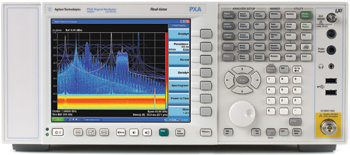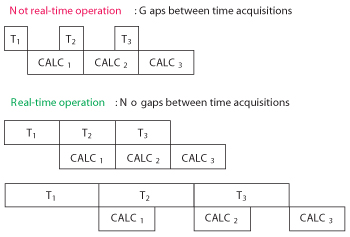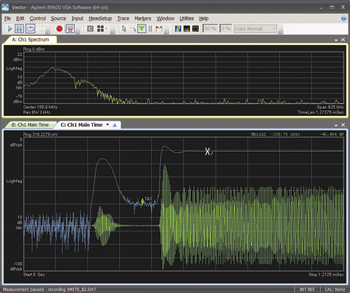
Figure 1 A real-time PXA is a cost effective solution that can identify spurious signals and then observe pulsed spurs using the real-time mode.
In aerospace, defense and wireless communications, a variety of evolving challenges are making system characterization and troubleshooting more difficult. For example, radar and electronic warfare (EW) systems are becoming more dynamic and faster-moving, and may cover many cubic miles of airspace above a battlefield. The proliferation of multi-format, high-rate communication systems is leading to a much higher probability of interoperability issues.
As signals continue to become increasingly complex and agile, gap-free measurement techniques such as real-time spectrum analysis and time capture are gaining acceptance in mainstream applications. Instruments such as Agilent’s PXA signal analyzer are taking this a step farther into the mainstream by making these capabilities available within a traditional signal analyzer rather than a dedicated or single-purpose instrument (see Figure 1).
Agilent’s real-time spectrum analyzer (RTSA) capability is an upgrade option for new and existing PXAs, making the PXA the first traditional signal analyzer to offer the opportunity to add real-time analysis after the purchase. This makes real-time capability available for about one-tenth the cost of purchasing a new real-time analyzer.
Adding RTSA lets the user see, capture and understand highly elusive signals on the lab bench or in the field. For deeper analysis, a user can combine a real-time PXA with the Agilent 89600 VSA software to create a solution that enables thorough characterization of complex and modulated signals.

Figure 2 Real-time operation occurs when the calculation speed is fast enough to ensure gap-free analysis of sampled data.
Defining Real-Time Analysis
Although the phrase “real-time analysis” can mean different things to different people, a consistent core concept can be defined as follows: In a spectrum or signal analyzer with a digital intermediate frequency (IF) section, real-time operation is a state in which all signal samples are processed for some sort of measurement result or triggering operation (see Figure 2). In most cases the measurement results are scalar (e.g., power or magnitude), corresponding to traditional spectrum measurements. In this case, each CALC operation includes the computation of a fast Fourier transform (FFT) or power spectrum as well as averaging, display updates, and so on. In addition to gap-free analysis, a real-time RF analyzer may be defined as having four more key attributes: high-speed measurements, consistent measurement speed, advanced composite displays and frequency-mask triggering (FMT).
In general, the stream of spectra from real-time processing can be used in one of two ways: The spectra can be combined into a composite spectrum display or successively compared to a limit mask to implement FMT. Both of these capabilities are present in a real-time PXA equipped with the RTSA option.
Implementing Real-Time Spectrum Analysis in the PXA
As with a dedicated real-time spectrum analyzer, the real-time PXA uses ASICs and FPGAs to convert sampled signal data into signal spectra at nearly 300,000 spectra per second. Spectrum data is combined to create information-rich displays such as density or histograms. Alternatively, the stream of spectra can be sequentially tested against limits and logical criteria to produce a spectrum- and behavior-specific frequency-mask trigger.
To make worthwhile contributions in real-time spectrum analysis, the Agilent design team focused on four key areas: bandwidth, dynamic range, probability of intercept (POI) and integrated analysis capabilities.
Bandwidth
As the signal bandwidths and frequency spans to be analyzed increase, greater bandwidth is necessary. With maximum analysis bandwidth of 160 MHz for real-time measurements, a PXA equipped with RTSA can address today’s wideband signals and signal environments. This gap-free bandwidth applies not only to real-time spectrum analysis but also to FMT, gap-free time capture and real-time magnitude calculations for IF triggering.
Another key point: unlike some similar analyzers, a real-time PXA always gathers gap-free data for bandwidths up to 160 MHz. The user can be confident that real-time mode is consistently capturing detailed information about intermittent or rapidly changing signals.
Dynamic Range
The real-time PXA enables detection of small, fleeting and infrequent signals in the presence of large ones by providing spurious-free dynamic range of up to −75 dB across the full 160 MHz bandwidth. Dynamic range is enhanced by the low noise floor of the PXA itself and, when dealing with very small signals, this can be further enhanced with a “low noise path” option that improves sensitivity while simultaneously handling high-level signals. In all cases, the PXA’s low noise floor increases the separation between small signals and noise.
Probability of intercept (POI)
POI is the key benchmark for real-time analysis and the real-time PXA can detect signals as short as 5.0 ns, measuring down to 3.57 μs with 100 percent POI and full amplitude accuracy. Gap-free analysis is just one element of POI. Within an instrument, the other contributing factors include analyzer and processor dynamic range (including sensitivity), sampling bandwidth, processing continuity and FFT processing overlap (which compensates for the shape of windowing functions).

Figure 3 Vector signal analysis can show detail such as time-gated spectrum (top) and simultaneous views of the signal such as power envelope (blue) and time waveform (green).
Integrated Analysis Capabilities
In some cases, simply finding an elusive signal is sufficient: the mere presence of a signal — and perhaps its overall spectral shape — may be all that’s needed to answer a question, confirm a problem or suggest a solution. In other situations, finding the signal is just the first step toward a solution to a problem in a system or signal environment.
Using VSA software with a real-time PXA enables thorough analysis and demodulation of signals acquired in real-time mode. In addition, real-time FMT can be used to focus all VSA measurement functions — including demodulation and time capture — on highly elusive signals (see Figure 3). These capabilities are especially effective when measuring modulated transients, frequency-hopping signals, frequency settling, and undesired transients in signal sources such as voltage-controlled oscillators (VCO).
Fully Utilizing Signals Acquired in Real-Time
Two additional capabilities are worth a closer look: histogram or density displays and frequency-mask triggering.
Histogram or Density Displays
To capture the dynamics of agile or fleeting signals, real-time spectrum analyzers generate thousands of spectra every second. Because this is more than the human eye can discern, it is necessary to represent large amounts of measurement data in a single display trace. As an example, the real-time PXA can produce nearly 300,000 spectra per second but most people can see only 30 per second. Thus, to present real-time results in a meaningful way, each display update needs to represent about 10,000 results.
In a real-time analyzer, informative displays are created by compiling statistics and displaying how often a particular measurement value occurs (e.g., specific amplitude at a specific frequency). This histogram of measurement results is a spectrum measurement enhanced to show frequency of occurrence, and some may consider this to be a backward-looking version of probability.
These displays are coded using color or intensity, and a persistence function can be added to focus attention on more recent events as older data fades away. Trace data such as the most recent single display update, or an average, can also be overlaid as a trace that looks similar to a traditional spectrum measurement.
This approach allows engineers to see and focus on infrequent events or transients, then separate them from other behavior. By changing persistence and color-weighting values or schemes, specific behaviors can be highlighted. The real-time PXA enables interpretation and analysis of results providing complete trace-marker capabilities with persistence displays.
FMT Technology
When looking for a specific signal, FMT compares the high-speed data stream to a user-defined spectrum mask. A trigger is generated when the mask is exceeded or when the signal enters the mask region. This capability is made more useful with conditional triggering on actions such as a signal exiting or re-entering the mask.
In the real-time PXA, masks can be a combination of upper and lower limits, and can be entered numerically or graphically. As a time-saving feature, the analyzer can use the measured signal environment to automatically generate a mask, which the user can modify as needed. To simplify this process, the mask is shown along with the live measured trace.
FMT may be used to generate successive triggers on a relatively frequent basis. In contrast, one of its most powerful uses is those situations in which the behavior to be measured is very rare, with gaps of minutes or hours between events. If the VSA software is included, pre- and post-trigger delays can be used to capture the beginning or end of an event, or anything in between.
Enhancing Utility
In most organizations, today’s economic climate increases the pressure to fully utilize existing equipment such as traditional signal analyzers. On the flip side, tight spending controls make it harder to justify single-purpose tools such as dedicated real-time analyzers.
This is one of the key reasons Agilent decided to create RTSA as an upgrade option that can be added to new or existing PXA signal analyzers. It is also one of the reasons why the PXA was designed from day 1 with an architecture that enables the addition of new capabilities such as RTSA. The result is an analyzer that provides both traditional and real-time capabilities in one unit — and delivers consistent performance when using either mode at a cost that is much less than purchasing a new hardware.
Agilent Technologies
Santa Clara, CA
(800) 829-4444
www.agilent.com
